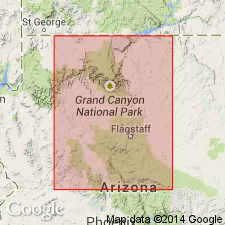
- Usage in publication:
-
- Carbon Canyon Member
- Modifications:
-
- First used
- AAPG geologic province:
-
- Plateau sedimentary province
- Southern Rocky Mountain region
Summary:
First use of the Carbon Canyon Member of the Galeros Formation of the Chuar Group. Age is late Precambrian.
Source: GNU records (USGS DDS-6; Menlo GNULEX).
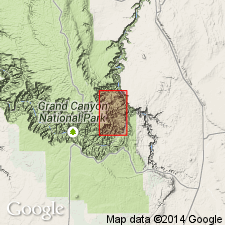
- Usage in publication:
-
- Carbon Canyon Member
- Modifications:
-
- [Principal reference]
- Dominant lithology:
-
- Limestone
- Shale
- Sandstone
- AAPG geologic province:
-
- Plateau sedimentary province
- Southern Rocky Mountain region
Summary:
Pg. 1244 (table 1), 1246 (fig. 4), 1247 (fig. 6), 1248-1250, geol. map (fig. 1), columnar section (fig. 2). Carbon Canyon Member of Galeros Formation of Chuar Group. Alternating limestones and shales, with some sandstone beds. Top of member placed at highest limestone bed; base is placed at lowest limestone bed. Total thickness 1,546 feet (471 m). Underlies Duppa Member (new) and overlies Jupiter Member (new); both of Galeros Formation (new). Appears = Walcott's lower divisions 2b-2e, 3, and 4 of Chuar terrane [USGS Ann. Rpt. 14, p. 508-509, 1894], and part of Hinds' divisions 4 and 5 of Chuar Group [Carnegie Inst. Washington Pub. 463, p. 105-106, 1936]. Fossils (stromatolite BAICALIA aff. B. RARA Semikhatov occurs about 230 feet from top of member). Age is late Precambrian.
Type section: Carbon Canyon section C, [southwest of Carbon Butte in West Fork Carbon Creek and Lava Creek area, approx. Lat. 36 deg. 10 min. N., Long. 51 deg. 10 min. W., Cape Solitude 7.5-min quadrangle], eastern Grand Canyon, Grand Canyon National Park, Coconino Co., northern AZ.
Named from Carbon Canyon [derived from Carbon Creek and its East and West Forks which flow through it (AZ-T101, p. 140; U.S. Board on Geographic Names, ca. 2000), Cape Solitude 7.5-min quadrangle], eastern Grand Canyon, Grand Canyon National Park, Coconino Co., northern AZ.
[Additional locality information from USGS GNIS database and USGS historical topographic map collection TopoView, accessed on October 5, 2024.]
Source: Publication; supplemental information from US geologic names lexicon (USGS Bull. 1520, p. 52).
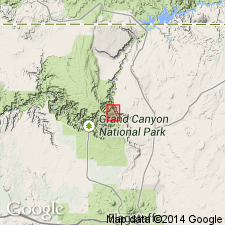
- Usage in publication:
-
- Carbon Canyon Member*
- Modifications:
-
- Adopted
- AAPG geologic province:
-
- Plateau sedimentary province
- Southern Rocky Mountain region
Summary:
Carbon Canyon Member of the Galeros Formation of the Chuar Group of the Grand Canyon Supergroup is adopted. Age is late Precambrian.
Source: GNU records (USGS DDS-6; Menlo GNULEX).
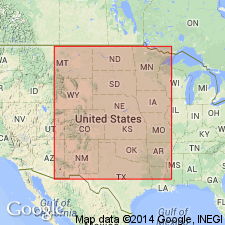
- Usage in publication:
-
- Carbon Canyon Member*
- Modifications:
-
- Age modified
- AAPG geologic province:
-
- Plateau sedimentary province
- Southern Rocky Mountain region
Summary:
Age of the Carbon Canyon Member of the Galeros Formation is modified from late Precambrian to: Proterozoic Y.
Source: GNU records (USGS DDS-6; Menlo GNULEX).
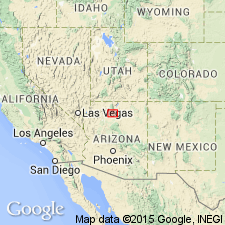
- Usage in publication:
-
- Carbon Canyon Member*
- Modifications:
-
- Age modified
- AAPG geologic province:
-
- Plateau sedimentary province
- Southern Rocky Mountain region
Summary:
Carbon Canyon Member of Galeros Formation of Chuar Group of Grand Canyon Supergroup. Underlies Duppa Member and overlies Jupiter Member; both of Galeros Formation. Thickness 350 m. Age changed from Proterozoic Y to Late Proterozoic (age term applied to rocks approximately 900 to 570 Ma). Change in age applies to Galeros and its (ascending) Tanner, Jupiter, Carbon Canyon, and Duppa Members in the Southern Rocky Mountain region of northern AZ. Shown as younger than 850 Ma (est). Columnar section.
Source: GNU records (USGS DDS-6; Denver GNULEX).
For more information, please contact Nancy Stamm, Geologic Names Committee Secretary.
Asterisk (*) indicates published by U.S. Geological Survey authors.
"No current usage" (†) implies that a name has been abandoned or has fallen into disuse. Former usage and, if known, replacement name given in parentheses ( ).
Slash (/) indicates name conflicts with nomenclatural guidelines (CSN, 1933; ACSN, 1961, 1970; NACSN, 1983, 2005, 2021). May be explained within brackets ([ ]).

